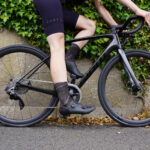One of the most compelling advantages of choosing a Swytch Bike conversion kit is the seamless transition it offers. Your bicycle remains fundamentally the same, retaining the familiar feel you’ve come to appreciate. There’s no need to adapt to new handling quirks or unfamiliar gearing systems. The handlebars respond just as you expect, and the tires maintain their accustomed grip. Even with the Swytch system installed, you have the freedom to enjoy your bike as a purely mechanical machine. Simply detach the battery pack, and your trusty bicycle is ready for a ride in its original form – perhaps just a touch heavier due to the addition of the wheel motor.
Image alt text: Cyclist enjoying an urban ride on a bicycle equipped with a Swytch electric conversion kit.
The Unique “Ghost Foot” Sensation of Swytch Bikes
The Swytch motor is intelligently designed to respond primarily to the cadence sensor, a component you discreetly attach to your bike’s frame. This sensor diligently monitors the rotation of a disc near your bottom bracket, translating your pedaling rhythm into electric assistance. While an optional throttle is available, it’s important to note that the Swytch system isn’t engineered for rapid launches from a standstill for most riders. Typically, it requires a brief 15 to 20 degrees of crank or pedal rotation before the motor engages, and the power delivery is characterized by a gradual ramp-up rather than an immediate surge.
This nuanced engagement means that a little forethought about gear selection is beneficial, especially when navigating stop-and-go traffic or technical trails. If your converted bike boasts a versatile range of gears, adapting to this characteristic will be straightforward. However, if you’re considering Swytch with the expectation of transforming an inherently impractical bike into a marvel of usability, it’s wise to reconsider. Swytch kits truly excel at enhancing, improving, and extending the capabilities of your existing bike, not fundamentally reinventing its nature. You remain actively engaged in pedaling when riding a Swytch bike, and the overall experience closely mirrors traditional cycling. It’s unlikely to evoke the sensation of riding an electric moped, unless you fully engage the throttle on open, unobstructed stretches of road.
Unleashing the Potential: Swytch Assistance Levels in Action
Once you’re in motion, the Swytch system truly demonstrates its capabilities. It offers five distinct levels of assistance, allowing you to tailor the electric support to your riding needs and preferences. Even at the most conservative level one setting, you’ll immediately perceive a difference. Inclines seem less daunting, and each pedal stroke translates to noticeably extended coasting distances. Stepping up to level three introduces that distinctive e-bike sensation where, under normal conditions, you might find yourself merely spinning the pedals to maintain momentum, unless you intentionally shift into higher gears to increase resistance and effort. Levels four and five, in my experience, are best reserved for tackling particularly challenging hills or for experimental bursts of speed on long, empty roads. For everyday riding, I generally prefer to conserve battery life by primarily utilizing levels one through three. These levels strike a harmonious balance, amplifying the effectiveness of your pedaling input and allowing you to cover more ground with comparable effort. In essence, Swytch empowers you to make each pedal stroke count for more, expanding your riding horizons and making cycling even more enjoyable.


